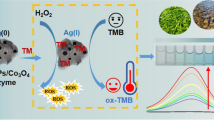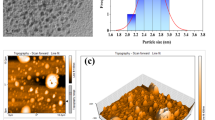Abstract
A colorimetric assay has been developed for facile, rapid, and sensitive detection of Cd2+ using 1-amino-2-naphthol-4-sulfonic acid functionalized silver nanoparticles (ANS-AgNPs). The presence of Cd2+ induces the aggregation of ANS-AgNPs through cooperative metal–ligand interaction. As a result, the characteristic surface plasmon resonance (SPR) peak of ANS-AgNPs at 390 nm was red-shifted to 580 nm, yielding a color change from bright yellow to reddish-brown. The color change is monitored by UV–Vis spectrometer and can be directly read out by the naked eye. Under the optimized conditions, a good linear relationship (correlation coefficient R = 0.997) was obtained between the ratio of the absorbance at 580 nm to that at 390 nm (A580nm/A390nm) and the concentration of Cd2+ over the range of 1.0–10 μM with detection limit of 87 nM. The proposed method is simple and efficient, which has been applied for determining Cd2+ in milk powder, serum, and lake water with satisfactory results.

The bare AgNPs were functionalized with ANS and used as sensors for the colorimetric detection of Cd2+ by taking advantage of metal chelation of Cd2+ with the hydroxyl group (–OH) and amino group(–NH2) of ANS on the surface of AgNPs, which resulted in an appreciable colo r changed from bright yellow to reddish-brown.






Similar content being viewed by others
References
Akesson A, Julin B, Wolk A (2008) Long-term dietary cadmium intake and postmenopausal endometrial cancer incidence: a population-based prospective cohort study. Cancer Res 68:6435–6441
Chansuvarn W, Tuntulani T, Imyim A (2015) Colorimetric detection of mercury(II) based on gold nanoparticles, fluorescent gold nanoclusters and other gold-based nanomaterials. Trends in Anal Chem 65:83–96
Chen WW, Cao FJ, Zheng WS, Tian Y, Xian YL, Xu P, Zhang W, Wang Z, Deng K, Jiang XY (2015a) Detection of the nanomolar level of total Cr[(III) and (VI)] by functionalized gold nanoparticles and a smartphone with the assistance of theoretical calculation models. Nanoscale 7:2042–2049
Chen HM, Hu WH, Li CM (2015b) Colorimetric detection of mercury(II) based on 2,2,-bipyridyl induced quasi-linear aggregation of gold nanoparticles. Sensors Actuators B Chem 215:421–427
Daher RT (1995) Trace metals (lead and cadmium exposure screening). Anal Chem 67:405R–410R
Darwish IA, Blake DA (2001) One-step competitive immunoassay for cadmium ions: development and validation for environmental water samples. Anal Chem 73:1889–1895
Davis AC, Wu P, Zhang XF, Hou XD, Jones BT (2006) Determination of cadmium in biological sample. Appl Spectrosc 41:35–75
Dobson S (1992) Cadmium: environmental aspects. World Health Organization, Geneva
Friberg L, Elinder CG, Kjellstrom T (1992) Cadmium. World Health Organization, Geneva
Guo W, Hu SH, Xiao YF, Zhang HF, Xie XJ (2010) Direct determination of trace cadmium in envirinmental samples by dynamic reaction cell inductively coupled plasma mass spectrometry. Chemosphere 81:1463–1468
Guo YG, Zhang Y, Shao HW, Wang Z, Wang XF, Jiang XF (2014) Label-free colorimetric detection of cadmium ions in rice samples using gold nanoparticles. Anal Chem 86:8530–8534
Jaliehvand F, Leung BO, Mah V (2009) Cadmium(II) complex formation with cysteine and penicillamine. Inorg Chem 48:5758–5771
Jane AM, Matin MS, Amy T, John MH, Polly AN (2006) Cadmium exposure and breast cancer risk. J Natl Cancer Inst 98:869–873
Kumar VV, Anthony SP (2014) Silver nanoparticles based selective colorimetric sensor for Cd2+, Hg2+, and Pb2+ ions: tuning sensitivity and selectivity using co-stabilizing agents. Sensors Actuators B Chem 191:31–36
Li HB, Li FY, Han CP, Cui ZM, Xie GY, Zhang AQ (2010) Highly sensitive and selective tryptophan colorimetric sensor based on 4,4-bipyridine-functionalized silver nanoparticles. Sensors Actuators B Chem 145:194–199
Manjumeena R, Duraibabu D, Rajamuthuramalingam T, Venkatesan R, Kalaichelvan PT (2015) Highly responsive glutathione functionalized green AuNPs probe for precise colorimetric detection of Cd2+ contamination in the environment. RSC Adv 5:69124–69133
Martinez RH, Blasco IN (2012) Estimation of dietary intake and content of lead and cadmium in infant cereals marketed in Spain. Food Control 26:6–14
Matsumoto A, Osaki S, Kobata T, Hashimoto B, Uchihara H, Nakahara T (2010) Determination of cadmium by an improved double chamber electrothermal vaporization inductively coupled plasma atomic emission spectrometry. Microchem J 95:85–89
McLaughlin MJS, Singh BR (1999) Cadmium in soils and plants. Kluwer, Dordrecht
Medley CD, Smith JE, Tang ZW, Wu YR, Bamrungsap S, Tan WH (2008) Gold nanoparticle-based colorimetric assay for the direct detection of cancerous cells. Anal Chem 80:1067–1072
Mehta VN, Singhal RK, Kailasa SK (2015) A molecular assembly of piperidine carboxylic acid dithiocarbamate on gold nanoparticles for the selective and sensitive detection of Al3+ ion in water samples. RSC Adv 5:33468–33477
Mirabi A, Dalirandeh Z, Rad AS (2015) Preparation of modified magnetic nanoparticles as a sorbent for the preconcentration and determination of cadmium ions in food and environmental water samples pripr to flame atomic absorption spectrometry. J Magn Magn Mater 381:138–144
Ratnarathron N, Chailapakul O, Dungchai W (2015) Highly sensitive colorimetric detection of lead using maleic acid functionalized gold nanoparticles. Talanta 132:613–618
Sharif T, Niaz A, Najeeb M, Zaman MI, Ihsan M, Sirajuddin (2015) Isonicotinic acid hydrazide-based silver nanoparticles as simple colorimetric sensor for the detection of Cr3+. Sensors Actuators B Chem 216:402–408
Wan Z, Xu ZR, Wang JH (2006) Flow injection on-line solid phase extraction for ultra-trace lead screening with hydride generation atomic fluorescence spectrometry. Analyst 131:141–147
Willemse CM, Tlhomelang K, Jahed N, Baker PG, Iwuoha EI (2011) Metallo-graphene nanocomposite electrocatalytic platform for the determination of toxic metal ions. Sensors 11:3970–3987
Xue Y, Zhao H, Wu ZJ, Li XJ, He YJ, Yuan ZB (2011) Colorimetric of Cd2+ using gold nanoparticles cofunctionalized with 6-mercaotonicotinic acid and L-cysteine. Analyst 136:3725–3730
Yang NN, Gao YX, Zhang YJ, Shen ZY, Wu AG (2014) A new rapid colorimetric detection method of Al3+ with high sensitivity and excellent selectivity based on a new mechanism of aggregation of smaller etched silver nanoparticles. Talanta 122:272–277
Yunus S, Charles S, Dubois F, Vander Donckt E (2008) Simultaneous determination of cadmium(II) and zinc(II) by molecular fluorescence spectroscopy and multiple linear regression using an anthrylpentaazamacrocycle chemosensor. J Fluoresc 18:499–506
Zhan SS, Xu HC, Zhan XJ, Wu YG, Wang LM, Lv J, Zhou P (2015) Determination of silver(I) ion based on the aggregation of gold nanoparticles caused by silver-specific DNA, and its effect on the fluorescence of rhodamine B. Microchim Acta 182:1411–1419
Zhang M, Ye BC (2011) Colorimetric chiral recognition of enantiomers using the nucleotide-capped silver nanoparticles. Anal Chem 83:1504–1509
Zhang M, Liu YQ, Ye BC (2012) Colorimetric assay for parallel detection of Cd2+, Ni2+, and Co2+ using peptide-modified gold nanoparticles. Analyst 137:601–607
Acknowledgments
The first two authors contributed equally to this work. This work is financially supported by the Natural Science Foundation of China (Nos. 21365014, 21505067) and Jiangxi ProvinceScience and Technology University Ground Plan project (KJLD No. 14007).
Author information
Authors and Affiliations
Corresponding author
Electronic supplementary material
ESM 1
(DOC 4240 kb)
Rights and permissions
About this article
Cite this article
Huang, P., Liu, B., Jin, W. et al. Colorimetric detection of Cd2+ using 1-amino-2-naphthol-4-sulfonic acid functionalized silver nanoparticles. J Nanopart Res 18, 327 (2016). https://doi.org/10.1007/s11051-016-3630-8
Received:
Accepted:
Published:
DOI: https://doi.org/10.1007/s11051-016-3630-8




